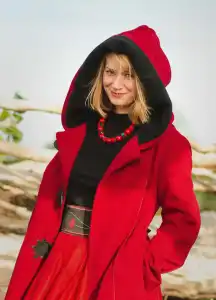Some Thoughts with ... Gabriela Houston
3 Jun 2024The Author/s

Gabriela Houston
Gabriela Houston is a London-based writer. She was born in Poland and raised in a book-loving household on the nourishing diet of mythologies, classics and graphic novels. She had spent much of her early school years holed up in the library, only feeling truly herself in the company of Jack London’s trappers and Lucy Maud Montgomery’s red-headed orphan, among many others.
She came to the UK at 19 to follow her passion for literature and she completed her undergraduate and Masters degrees at Royal Holloway, University of London.
After her studies she worked in publishing for a few years. She now lives with her family in Harrow, where she pursues her life-long passion for making stuff up.
She’s represented by John Baker from Bell Lomax Moreton Agency.
The Interview
1.- Could you introduce yourself to Jamreads’ readers?
Hello, I’m Gabriela Houston. I’m a Polish artist and writer living in the UK. I’m the author of four Slavic-foklore-inspired novels for adults (The Second Bell & The Bone Roots) and children (The Wind Child & The Storm Child).
2.- How did you start writing?
It’s something I have always done, writing poems, short stories, comics scripts. Like most writers, I started off as a voracious reader though, reading everything I got my hands on.
3.- English is your second language, as you are from Polish origins. Did you find writing in English difficult because of it?
I came here at 19 to study English literature, and have now lived in the UK longer than I ever lived in Poland. English is my main language now, for sure. It’s a stranger and complicated process, one language waning, another taking its place. I heard Salman Rushdie talk once of how writers import the melody of their mother tongue into their second language. I definitely find it can be used to create an interesting effect in fiction. Language shapes how people think. The things they have words for; the things they don’t or do notice. It’s something I think about a lot in my own writing.
4.- All your writing is influenced by Slavic folklore. Would you say this is a sort of homage to your origins?
All my writing so far, I would say (I’m currently working on something quite different). It’s not so much an homage I would say as an expression of my interest in Eastern European folklore and how mythologies, in general, express a community’s values. Slavic folklore is so rich and multilayered, and I think deserves its moment in the spotlight.
5.- You’ve already written a series for younger readers (The Wind Child & The Storm Child duology) and some adult novels. Do you find writing different from other?
Definitely, the way you structure the stories is very different. Children are less tolerant of the lulls in the narrative. You have to be more economical in your descriptions, side plots etc, so as not to lose their attention. Adults, I find, enjoy the longer moments of peace in the books, moments of reflection. In the subject matter, when it comes to children’s books, I believe in not shying away from difficult subjects. The Wind Child duology covers a lot of difficult subjects (grief, childhood loneliness, dual identities), and I think all of it deserves to be discussed, as long as you give it the respect and the dignity the subject deserves.
6.- How did the idea for this anthology, Whispers of the Earth, appear?
I was doing a linocut print inspired by the Anansi myth and my friend, Rachael Twumasi-Corson, asked if I’d like to collaborate on a short story inspired by it, and we could submit it to magazines etc. It made me wonder if we could do something bigger ourselves instead. I reached out to a lot of writers I know, and the response has been very positive.
Stephen Aryan, one of the contributors, suggested we go the Kickstarter route, and the folk at The Broken Binding offered to assist with the printing and the distribution, which was amazing and allowed us to elevate the whole concept.
The main idea was to create a collection of stories inspired by how folklore lives, grows, and travels with people. We have stories pulling from multiple cultures, and then some that offer a meditation on the dangers of forgetting the old wisdoms.
7.- Could you tell us more about the process of recruiting this stellar line-up of authors for the anthology? How did they choose the theme of their story?
After a few years into my publishing journey, I was lucky enough to meet a number of very accomplished authors. Since my own published works are heavily inspired by folklore, I have also had the chance to interact with writers specializing in that subject, which helped a lot. Then existing contributors recommended others, and so we have put the team together.
I gave the contributors the concept of what the anthology was, and they each brought me their interpretation of it.
8.- The anthology includes illustrations made by yourself linocutting them. Why did you choose this medium to illustrate them?
I think it really works as a traditional medium, to best illustrate the traditional stories, given a new lease of life, as it were.This blend of tradition and modernity was key to the project. The idea with the Kickstarter is to allow us to create a project that traditional publishers would generally consider too expensive to produce. As an artist, I always want to make the books as beautiful as humanly possible. This project allows us to do just that.
Also, in the world where AI is creeping into the art space, there’s something satisfyingly defiant about creating with the very tactile, traditional methods.
9.- Which piece of Slavic folklore would you say is your favourite, and why?
A lot to choose from! I think I love the myths of Uncle Borovy and Auntie Borova best. The protectors of the forest, they best encapture the division within the spirit world as seen by the Ancient Slavs. It was recognised that not all the world is for us and about us. Having creatures within the folklore that did not exist specifically to cater to us/hurt us really illustrates that point well.
For my short story in the anthology I picked Kozitka. It’s the aged form of a rusalka (the spirit of drowned women), who still wants to lure men to their watery grave, but no longer has the beauty to accomplish that task easily. I love how this creature both allows me to lean into the body horror elements I enjoy writing, while also illustrating a very powerful point: that while stories of folklore age, and might seem old and irrelevant, are still very much powerful.
10.- What can we expect from Gabriela Houston in the future?
I’m working on a new project that is quite different from my previous books, but I can’t say anything about it yet. So watch this space!
Whispers in the Earth is currently available in Kickstarter. It's fully funded, and they are currently unlocking more stretch goals, so it's an excellent opportunity to support this initiative.

